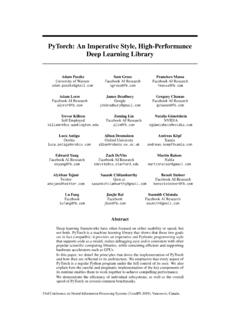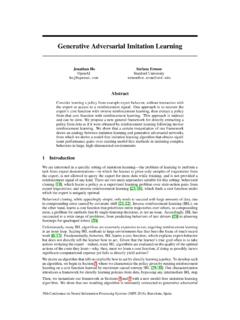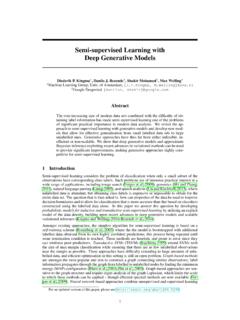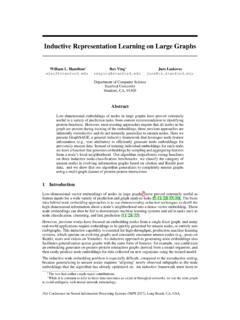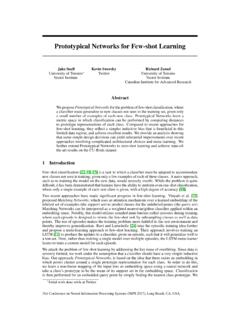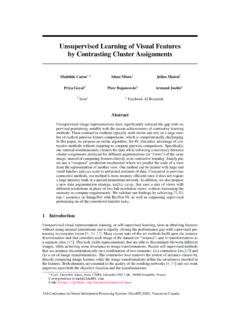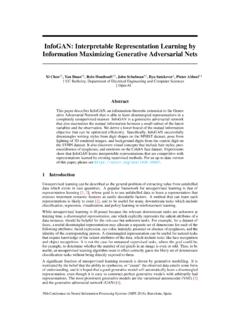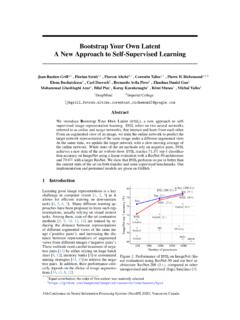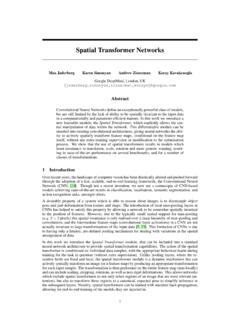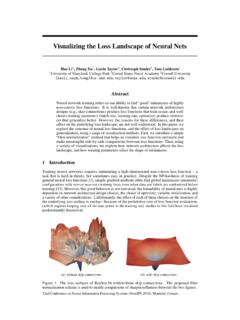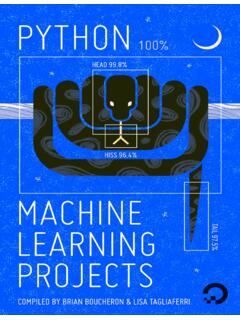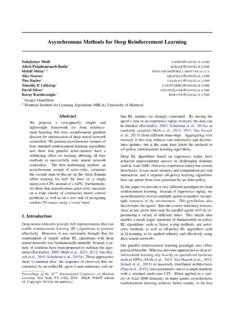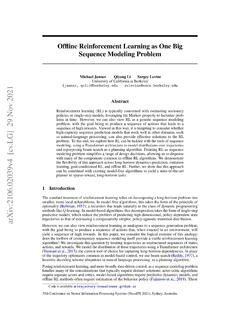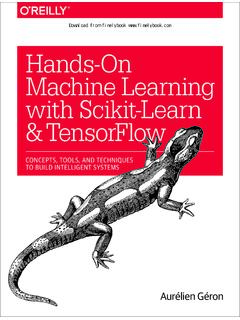Transcription of Hierarchical Deep Reinforcement Learning: Integrating ...
1 Hierarchical deep Reinforcement learning : Integrating Temporal Abstraction andIntrinsic MotivationTejas D. Kulkarni DeepMind, R. Narasimhan CSAIL, SaeediCSAIL, B. TenenbaumBCS, goal-directed behavior in environments with sparse feedback is a majorchallenge for Reinforcement learning algorithms. One of the key difficulties is in-sufficient exploration, resulting in an agent being unable to learn robust motivated agents can explore new behavior for their own sake ratherthan to directly solve external goals. Such intrinsic behaviors could eventuallyhelp the agent solve tasks posed by the environment. We present Hierarchical -DQN (h-DQN), a framework to integrate Hierarchical action-value functions, op-erating at different temporal scales, with goal-driven intrinsically motivated deepreinforcement learning .
2 A top-level q-value function learns a policy over intrinsicgoals, while a lower-level function learns a policy over atomic actions to satisfythe given goals. h-DQN allows for flexible goal specifications, such as functionsover entities and relations. This provides an efficient space for exploration incomplicated environments. We demonstrate the strength of our approach on twoproblems with very sparse and delayed feedback: (1) a complex discrete stochas-tic decision process with stochastic transitions, and (2) the classic ATARI game Montezuma s Revenge .1 IntroductionLearning goal-directed behavior with sparse feedback from complex environments is a fundamentalchallenge for artificial intelligence. learning in this setting requires the agent to represent knowl-edge at multiple levels of spatio-temporal abstractions and to explore the environment , non-linear function approximators coupled with Reinforcement learning [14, 16, 23] havemade it possible to learn abstractions over high-dimensional state spaces, but the task of explorationwith sparse feedback still remains a major challenge.
3 Existing methods like Boltzmann explorationand Thomson sampling [31, 19] offer significant improvements over -greedy, but are limited due tothe underlying models functioning at the level of basic actions. In this work, we propose a frame-work that integrates deep Reinforcement learning with Hierarchical action-value functions (h-DQN),where the top-level module learns a policy over options (subgoals) and the bottom-level modulelearns policies to accomplish the objective of each option. Exploration in the space of goals enablesefficient exploration in problems with sparse and delayed rewards. Additionally, our experimentsindicate that goals expressed in the space of entities and relations can help constraint the explorationspace for data efficient deep Reinforcement learning in complex environments.
4 Equal Contribution. Work done while Tejas Kulkarni was affiliated with Conference on Neural Information Processing Systems (NIPS 2016), Barcelona, learning (RL) formalizes control problems as finding a policy that maximizesexpected future rewards [32]. Value functionsV(s)are central to RL, and they cache the utilityof any statesin achieving the agent s overall objective. Recently, value functions have also beengeneralized asV(s,g)in order to represent the utility of statesfor achieving a given goalg G[33, 21]. When the environment provides delayed rewards, we adopt a strategy to first learn waysto achieve intrinsically generated goals, and subsequently learn an optimal policy to chain themtogether. Each of the value functionsV(s,g)can be used to generate a policy that terminates whenthe agent reaches the goal stateg.
5 A collection of these policies can be hierarchically arrangedwith temporal dynamics for learning or planning within the framework of semi-Markov decisionprocesses [34, 35]. In high-dimensional problems, these value functions can be approximated byneural networks asV(s,g; ).We propose a framework with hierarchically organized deep Reinforcement learning modules work-ing at different time-scales. The model takes decisions over two levels of hierarchy (a) a top levelmodule (meta-controller) takes in the state and picks a new goal, and (b) a lower-level module (con-troller) uses both the state and the chosen goal to select actions either until the goal is reached orthe episode terminates. Themeta-controllerthen chooses another goal and steps (a-b) repeat.
6 Wetrain our model using stochastic gradient descent at different temporal scales to optimize expectedfuture intrinsic (controller) and extrinsic rewards (meta-controller). We demonstrate the strength ofour approach on problems with delayed rewards: (1) a discrete stochastic decision process with along chain of states before receiving optimal extrinsic rewards and (2) a classic ATARI game ( Mon-tezuma s Revenge ) with even longer-range delayed rewards where most existing state-of-art deepreinforcement learning approaches fail to learn policies in a data-efficient Literature ReviewReinforcement learning with Temporal AbstractionsLearning and operating over differentlevels of temporal abstraction is a key challenge in tasks involving long-range planning.
7 In thecontext of Hierarchical Reinforcement learning [2], Sutton et al.[34] proposed theoptionsframework,which involves abstractions over the space of actions. At each step, the agent chooses either a one-step primitive action or a multi-step action policy (option). Each option defines a policy overactions (either primitive or other options) and can be terminated according to a stochastic function . Thus, the traditional MDP setting can be extended to a semi-Markov decision process (SMDP)with the use of options. Recently, several methods have been proposed to learn options in real-timeby using varying reward functions [35] or by composing existing options [28]. Value functions havealso been generalized to consider goals along with states [21].
8 Our work is inspired by these papersand builds upon related work for Hierarchical formulations include the MAXQ framework [6], which decom-posed the value function of an MDP into combinations of value functions of smaller constituentMDPs, as did Guestrin et al.[12] in their factored MDP formulation. Hernandez and Mahadevan [13]combine hierarchies with short-term memory to handle partial observations. In the skill learning lit-erature, Baranes et al.[1] have proposed a goal-driven active learning approach for learning skills incontinuous sensorimotor this work, we propose a scheme for temporal abstraction that involves simultaneously learningoptions and a control policy to compose options in a deep Reinforcement learning setting. Ourapproach does not use separate Q-functions for each option, but instead treats the option as part ofthe input, similar to [21].
9 This has two potential advantages: (1) there is shared learning betweendifferent options, and (2) the model is scalable to a large number of MotivationThe nature and origin of good intrinsic reward functions is an open ques-tion in Reinforcement learning . Singh et al. [27] explored agents with intrinsic reward structures inorder to learn generic options that can apply to a wide variety of tasks. In another paper, Singhet al. [26] take an evolutionary perspective to optimize over the space of reward functions for theagent, leading to a notion of extrinsically and intrinsically motivated behavior. In the context ofhierarchical RL, Goel and Huber [10] discuss a framework for sub-goal discovery using the struc-tural aspects of a learned policy model.
10 S ims ek et al. [24] provide a graph partitioning approach tosubgoal [22] provides a coherent formulation of intrinsic motivation, which is measured bythe improvements to a predictive world model made by the learning algorithm. Mohamed andRezende [17] have recently proposed a notion of intrinsically motivated learning within the frame-work of mutual information maximization. Frank et al. [9] demonstrate the effectiveness of artificialcuriosity using information gain maximization in a humanoid robot. Oudeyer et al. [20] categorizeintrinsic motivation approaches into knowledge based methods, competence or goal based methodsand morphological methods. Our work relates to competence based intrinsic motivation but othercomplementary methods can be combined in future Reinforcement LearningObject-based representations [7, 4] that can exploit theunderlying structure of a problem have been proposed to alleviate thecurse of dimensionalityinRL.
